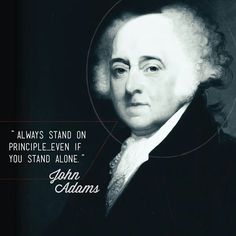On this day in 1735, John Adams, the son of a farmer and a descendant of Plymouth Rock pilgrims, is born in Braintree, Massachusetts. He enrolled in Harvard University at 16 and went on to teach school and study law before becoming America’s second president.
Adams did not fight in the Revolutionary War, but was instrumental in crafting the foundation of the American government. In 1776, he anonymously published Thoughts on Government, which proposed the three-tiered system upon which the United States government is modeled: a bicral legislature, independent judiciary and strong executive. In 1783, Adams brokered the peace treaty with Britain that ended the American Revolution. Fellow founding father Thomas Jefferson once referred to Adams as “the colossus of independence.” The two men developed a deep friendship during the Revolutionary era and both served in George Washington’s first cabinet–Adams as vice president and Jefferson as secretary of state.
Adams, Secretary of the Treasury Alexander Hamilton and James Madison articulated the basis of the Federalist policy— featuring above all a strong centralized government and favoring an economy based on manufacturing–that dominated the Washington and Adams presidencies. Jefferson, a Republican, favored stronger states’ rights and a primarily agricultural economy. Following Washington’s retirement in 1796, Jefferson and Adams ran against each other for the presidency. Adams won and, due to a procedure that gave the next highest vote-getter the vice-presidency, Jefferson became his adversary’s vice president. In personality as well as politics, the obstinate and hot-tempered Adams clashed with the genteel, diplomatic Thomas Jefferson and the two grew increasingly alienated during Adams’ presidency.
As president, Adams lobbied for and signed the Alien and Sedition Acts of 1798, which many observers, including Jefferson, feared would give Adams despotic powers. In Jefferson’s opinion, the acts threatened to compromise the constitutional right to free speech and severely limited the definition of citizenship. In the election of 1800, Jefferson again ran against Adams and, under the guise of a pseudonym or using ghost writers, published vicious denouncements of Adams’ policies and character in the press. Jefferson won and though Adams retired to Quincy, Massachusetts, to write his memoirs, the bitterness between the two former friends endured.
Throughout his political career, Adams was steadfastly supported—and sometimes challenged–by his wife, Abigail. The couple’s correspondence, which has been preserved, thoroughly catalogued and published, provides insight into their private lives and early American culture. When Abigail learned that Jefferson was behind the newspaper attacks against her husband, she too felt betrayed. Nevertheless, it was she who initiated contact between the sworn political enemies when she wrote a letter of condolence to Jefferson upon the death of his daughter in 1812. After that, Adams and Jefferson resumed their long-halted correspondence and repaired their friendship.
Adams lived to see his son, John Quincy Adams, become president in 1825. A year later, he and Thomas Jefferson died on the same day, July 4, 1826, only hours apart.


Dental Health, Fruit, Juice, Veggies and Water
A diet high in saturated fat, which can clog our arteries and lead to inflammation, is considered a key underlying causal factor for periodontal diseases like gingivitis. But, what about too much fruit and vegetables? By looking in your mouth your dentist...

Is Your Child New To Braces?
Tips for Braces When living with braces, there is a large amount of extra oral hygiene and care involved for kids to keep their mouth healthy and clean. Braces can be uncomfortable at times, care can be time consuming, and kids may feel overwhelmed...

Adult Orthodontics: Is It Too Late To Get Braces?
With developments in orthodontics in recent years, more and more adults are seeking treatment for oral difficulties they've been experiencing since childhood. There are significant differences between adult orthodontics and that of children and teens,...

